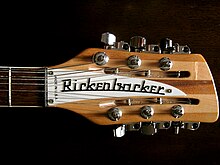Rickenbacker
[1] Adolph Rickenbacher and George Beauchamp founded the company in 1931 as the Ro-Pat-In Corporation (ElectRo-Patent-Instruments) to sell electric Hawaiian guitars.
On January 26, 1928, the National String Instrument Corporation opened, with a new factory located near a metal-stamping shop owned by Adolph Rickenbacher and staffed by experienced and competent craftsmen.
This ultimately resulted in part of the company's fractured management structure organizing support for George Beauchamp's newest project: development of a fully electric guitar.
[3]: 8–9 By the late twenties, the idea for electrified string instruments had been around for some time, and experimental banjo, violin, and guitar pickups had been developed.
In the summer of 1932, Ro-Pat-In began to manufacture cast aluminum production versions of the Fry-Pan as well as a lesser number of standard Spanish Electrics also known as "Electro-Spanish" models, built from wooden bodies similar to those made in Chicago for the National Company.
It also marks Rickenbacker's first link to the unit's originator, Clayton Doc Kauffman, who would become a design collaborator for the company a couple of years later.
Because the original aluminum Fry-Pans were susceptible to tuning problems from expansion of the metal under hot performing lights, they made many of the new models from cast Bakelite, an early synthetic plastic used in bowling balls.
Hall, owner of Radio & Television Equipment Co. (Radio-Tel), purchased the Electro String Company from Adolph Rickenbacker in 1953.
In 1956, Rickenbacker introduced two instruments with the "neck through body" construction that became a standard feature of many of the company's products, including the Combo 400 guitar, the model 4000 bass, and, later, the 600 series.
He eventually had the guitar's natural alder body refinished in black, and made other modifications, including adding a Bigsby vibrato tailpiece and regularly changing the control knobs.
During Lennon's post-Beatles years in New York, he had this guitar restored to its original natural wood finish and the cracked gold pickguard replaced with a white one.
While it was being repaired, Rickenbacker's UK distributor Rose Morris gave Lennon a model 1966 (the export version of a 325, available exclusively in a red finish and with an F-hole).
In the late 1970s and early 1980s, Rickenbacker guitars experienced a renaissance as new wave and jangle pop groups turned to them for their distinctive chime.
Some Rickenbacker models feature a stereo "Rick-O-Sound" output socket, allowing each pickup to be routed to different amplifiers or effects chains.
Known for their bright jangle and chime, early Rickenbacker guitars were often favored by folk rock, and British Invasion bands such as the Searchers, The Beatles and The Who.
Still, the early models were viewed by Pete Townshend as pivotal in his refinement of feedback techniques and the eventual development of the Marshall sound.
Along with McCartney, other early adopters of the 4001 were Roger Waters of Pink Floyd, John Entwistle of The Who, Pete Quaife of The Kinks,[citation needed] Chris Squire of Yes[9] (who technically used the RM1999 British import)[10] and Geddy Lee of Rush.
Later special editions included the 4003 Blue Boy, 4003 CS (Chris Squire), Blackstar, Shadow Bass, Tuxedo and 4003 Redneck.
In the 1970s, the Rickenbacker bass became a staple of progressive rock, as exemplified by British bassists Mike Rutherford (Genesis) and Chris Squire (Yes).
[9] Combined with his aggressive picking technique on Rotosound roundwound strings, the effect was a growling, grinding, "concrete mixer" tone that continues to be admired and emulated.
[citation needed] In the hard rock vein, Deep Purple's Roger Glover was a prominent Rickenbacker aficionado.
Another enthusiast was Metallica bassist Cliff Burton, whose heavily modified 4001, red with white hardware and trim, debuted during the group's Kill 'Em All era.
In 2019, the company produced a 420-bass run of Al Cisneros signature basses honoring the prominent Sleep and Om bassist, a long-time Rickenbacker proponent.
[11] The sound of Rickenbacker basses featured early on in the UK punk/New wave music explosion of the late 1970s and early 80s and was used by: Glen Matlock (Sex Pistols), Paul Simonon (The Clash), Peter Hook (Joy Division), Bruce Foxton (The Jam), Paul Gray (The Damned, Eddie & the Hot Rods), Tony James (Generation X), Michael Bradley (The Undertones), Youth (Killing Joke) and in the U.S., Mike Mills (R.E.M.)
In 1995, an effort was made to re-introduce Rickenbacker acoustics, with factory production beginning in their Santa Ana manufacturing facility in 1996.
Four models of flat top acoustic Rickenbackers were depicted in factory literature (maple or rosewood back and sides, jumbo or dreadnaught shape).
In late 2006, Rickenbacker gave a license to build Rickenbacker-branded acoustics to Paul Wilczynski, a luthier with a workshop in San Francisco, California.
He continued to offer all eight models of the Rickenbacker flat top guitar line, building each instrument to order, until his license expired on February 1, 2013.
Rickenbacker manufactures three pickups for their current standard models: high-gain single-coil, Vintage Toaster single coil, and humbucking.
Despite their slightly lower output, Toasters produce a brighter, cleaner sound, and are generally seen as key to obtaining the true British Invasion guitar tone, as they were original equipment of the era.




